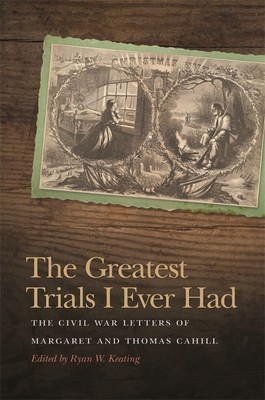
- We will send in 10–14 business days.
- Publisher: University of Georgia Press
- ISBN-10: 0820351547
- ISBN-13: 9780820351544
- Format: 15.2 x 22.9 x 1.8 cm, hardcover
- Language: English
- SAVE -10% with code: EXTRA
The Greatest Trials I Ever Had (e-book) (used book) | bookbook.eu
Reviews
Description
This edited collection of Civil War correspondence between Col. Thomas Cahill and his wife, Margaret, offers a rare glimpse into the symbiotic relationship between soldiers and their home communities. In the only substantial extant collection of letters from an Irish American woman on the northern home front, Margaret's pivotal role as a go-between in the financial affairs of men in the regiment and their wives is made evident, as is the broader interplay between the community of New Haven, Connecticut, and the regiment.
The couple's correspondence was nearly constant in their four years apart. There is an inherent intimacy in the way that daily life during the Civil War is documented and in particular in the gradual revelation of the emotional toll taken by a long-distance relationship. Because the volume includes letters from both Cahill and his wife, the interplay between the regiment and the home front is traced in a way most collections are not able to achieve. This lively correspondence provides a great introduction to primary source reading for students of the Civil War home front. These teaching opportunities will supplemented by a companion website that features more correspondence, maps, and additional learning materials.EXTRA 10 % discount with code: EXTRA
The promotion ends in 16d.03:25:09
The discount code is valid when purchasing from 10 €. Discounts do not stack.
- Publisher: University of Georgia Press
- ISBN-10: 0820351547
- ISBN-13: 9780820351544
- Format: 15.2 x 22.9 x 1.8 cm, hardcover
- Language: English English
This edited collection of Civil War correspondence between Col. Thomas Cahill and his wife, Margaret, offers a rare glimpse into the symbiotic relationship between soldiers and their home communities. In the only substantial extant collection of letters from an Irish American woman on the northern home front, Margaret's pivotal role as a go-between in the financial affairs of men in the regiment and their wives is made evident, as is the broader interplay between the community of New Haven, Connecticut, and the regiment.
The couple's correspondence was nearly constant in their four years apart. There is an inherent intimacy in the way that daily life during the Civil War is documented and in particular in the gradual revelation of the emotional toll taken by a long-distance relationship. Because the volume includes letters from both Cahill and his wife, the interplay between the regiment and the home front is traced in a way most collections are not able to achieve. This lively correspondence provides a great introduction to primary source reading for students of the Civil War home front. These teaching opportunities will supplemented by a companion website that features more correspondence, maps, and additional learning materials.

Reviews